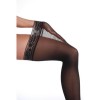 Fluid accumulation in the legs and its redistribution into the neck appears to play a role in obstructive sleep apnea (pauses in breathing during sleep).
Fluid accumulation in the legs and its redistribution into the neck appears to play a role in obstructive sleep apnea (pauses in breathing during sleep).
Researchers at Hopitaux de Paris, Groupe Hospitalier Pitie-Salpetriere, in Paris, France, studied the response to wearing compression stockings during the day.
First, the details.
- 12 non-obese people with chronic venous insufficiency and obstructive sleep apnea were randomly assigned to each treatment for one-week in random order.
- Wearing compression stockings
- Control period without compression stockings
- Polysomnography and measurement of overnight changes in leg fluid volume and neck circumference were performed.
- Polysomnography is used to measure physiological processes during sleep.
And, the results.
- Wearing compression stockings resulted a significant 62% reduction in the overnight leg fluid volume change and a significant 60% reduction in the overnight neck circumference increase.
- This was accompanied by a significant 36% reduction apnea (suspension of breathing) and hypopnea (shallow breathing or abnormally low respiratory rate) per hour of sleep.
The bottom line?
The authors concluded, “Redistribution of fluid from the legs into the neck at night contributes to the pathogenesis of obstructive sleep apnea in subjects with chronic venous insufficiency. Prevention of fluid accumulation in the legs during the day, and its nocturnal displacement into the neck at night, attenuates obstructive sleep apnea in such subjects.”
8/14/11 21:28 JR